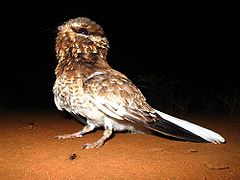Eleothreptus
| Eleothreptus[a] | |||
| G.R. Gray, 1840[1] | |||
 Przedstawiciel rodzaju – lelkowiec białoskrzydły (E. candicans) | |||
| Systematyka | |||
| Domena | |||
|---|---|---|---|
| Królestwo | |||
| Typ | |||
| Podtyp | |||
| Gromada | |||
| Podgromada | |||
| Infragromada | |||
| Rząd | |||
| Rodzina | |||
| Podrodzina | |||
| Rodzaj |
Eleothreptus | ||
| Typ nomenklatoryczny | |||
|
Amblypterus anomalus Gould, 1838 | |||
| Synonimy | |||
|
| |||
| Gatunki | |||
| |||
Eleothreptus – rodzaj ptaków z podrodziny lelków (Caprimulginae) w obrębie rodziny lelkowatych (Caprimulgidae).
Rozmieszczenie geograficzne[edytuj | edytuj kod]
Rodzaj obejmuje gatunki występujące w Ameryce Południowej (Brazylia, Boliwia, Paragwaj i Argentyna)[6].
Morfologia[edytuj | edytuj kod]
Długość ciała 18–23 cm; masa ciała 43,7–51 g[6].
Systematyka[edytuj | edytuj kod]
Rodzaj zdefiniował w 1838 roku brytyjski przyrodnik John Gould w artykule poświęconym nowemu rodzajowi z rodziny lelkowatych opublikowanym w czasopiśmie Proceedings of the Zoological Society of London[2]. Gatunkiem typowym jest (oznaczenie monotypowe) lelkowiec sierposkrzydły (E. anomalus). Jednak nazwa – Amblypterus – którą Gould nadał nowemu rodzajowi okazała się młodszym homonimem rodzaju wymarłych ryb promieniopłetwych opisanym w 1833 roku, dlatego w 1840 roku angielski ornitolog George Robert Gray nadał rodzajowi ptaków nową nazwę – Eleothreptus[1].
Etymologia[edytuj | edytuj kod]
- Amblypterus (Amplypterus): gr. αμβλυς amblus ‘tępy’, od αμβλυνω amblunō ‘stępić’; -πτερος -pteros ‘-skrzydły’, od πτερον pteron ‘skrzydło’[7].
- Eleothreptus (Eleothreptes, Heleothreptus): gr. ἑλεοθρεπτος heleothreptos ‘wychowany na bagnach’, od ἑλος helos, ἑλεος heleos ‘bagno’; τρεφω trephō ‘karmić’[8].
Podział systematyczny[edytuj | edytuj kod]
Do rodzaju należą następujące gatunki[9]:
- Eleothreptus candicans (von Pelzeln, 1867) – lelkowiec białoskrzydły
- Eleothreptus anomalus (Gould, 1838) – lelkowiec sierposkrzydły
Uwagi[edytuj | edytuj kod]
Przypisy[edytuj | edytuj kod]
- ↑ a b G.R. Gray: A list of the genera of birds: with their synonyma an indication of the typical species of each genus. London: R. and J.E. Taylor, 1840, s. 143. (ang.).
- ↑ a b J. Gould. Description of a New Genus (Amblypterus) among the Caprimulgidce, ancl characters of New Birds from Australia. „Proceedings of the Zoological Society of London”. 5, s. 105, 1838. (ang.).
- ↑ A.F.A. Wiegmann. Bericht über die Leistungen in Bearbeitung der übrigen Thierklassen, während des Jahres 1837. „Archiv für Naturgeschichte”. 4 (2), s. 380, 1838. (niem.).
- ↑ G.R. Gray: The genera of birds: comprising their generic characters, a notice of the habits of each genus, and an extensive list of species referred to their several genera. Cz. 1. London: Longman, Brown, Green, and Longmans, 1849, s. ryc. 17. (ang.).
- ↑ P.L. Sclater. Notes upon the American Caprimulgidæ. „Proceedings of the Zoological Society of London”. 1866, s. 143, 1866. (ang.).
- ↑ a b D.W. Winkler, S.M. Billerman & I.J. Lovette, Nightjars and Allies (Caprimulgidae), version 1.0, [w:] S.M. Billerman, B.K. Keeney, P.G. Rodewald & T.S. Schulenberg (redaktorzy), Birds of the World, Cornell Lab of Ornithology, Ithaca, NY 2024, Eleothreptus, DOI: 10.2173/bow.caprim2.01 [dostęp 2024-02-02] (ang.).

- ↑ The Key to Scientific Names ↓, Amblypterus [dostęp 2024-02-02].
- ↑ The Key to Scientific Names ↓, Eleothreptus [dostęp 2024-02-02].
- ↑ Systematyka i nazwy polskie za: P. Mielczarek & M. Kuziemko: Podrodzina: Caprimulginae Vigors, 1825 - lelki (wersja: 2023-12-03). [w:] Kompletna lista ptaków świata [on-line]. Instytut Nauk o Środowisku Uniwersytetu Jagiellońskiego. [dostęp 2024-02-02].
Bibliografia[edytuj | edytuj kod]
- The Key to Scientific Names, J.A. Jobling (red.), [w:] Birds of the World, S.M. Billerman et al. (red.), Cornell Lab of Ornithology, Ithaca (ang.).
